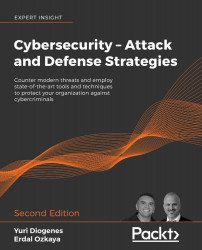Lateral Movement
In the previous chapters, the tools and techniques that attackers use to compromise and gain entry into a system were discussed. This chapter will focus on the predominant thing that attackers attempt to do following a successful entry: solidifying and expanding their presence. This is what is referred to as lateral movement. Attackers will move from device to device after the initial hack with the hopes of accessing high-value data. They will also be looking at ways in which they can gain additional control of the victim's network. At the same time, they will be trying not to trip alarms or raise any alerts. This phase of the attack life cycle can take a long time. In highly complicated attacks, the phase takes several months in order for the hackers to reach the desired target device.
Lateral movement involves scanning a network for other resources, the collecting and exploiting of credentials, or the collection of more information for exfiltration. It...



